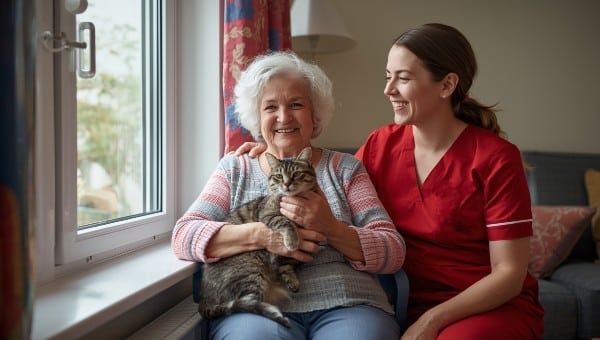Chronic pain is among the most common and consequential diseases worldwide. Nearly eight million Canadians are living with chronic pain and how the pain impacts both physical and mental health, inhibits work, play, relationships, and overall quality of life. November 2-8, 2025 is National Pain Awareness Week. Pain Canada creates new opportunities for action by connecting people, ideas, organizations and resources to enable a national movement.
During this week it is a time to raise awareness of chronic pain, its impacts, and how implementing An Action Plan for Pain in Canada can improve evidence-based care and support for all people with pain.
Chronic pain is a silent epidemic in older adults and is associated with significant suffering, social isolation, depression, insomnia and poor quality of life. It also adds more substantial costs and burdens to the healthcare system.
Chronic pain is pain that persists for longer than three months, past the point of typical tissue healing and can have various causes for senior loved ones, from natural wear and tear on the body’s muscles, nerves, and joints to underlying chronic health conditions. In other cases, older adults may suffer from “invisible” pain with no identifiable root cause. Often, invisible pain is related to autoimmune-related disorders such as fibromyalgia and chronic fatigue syndrome.
Chronic pain can have a severe ripple effect on other areas of the senior’s life and those around them if left unattended.
Chronic pain may lead to:
- Reduced mobility
- Trouble sleeping
- Avoiding activity
- Anxiety and Depression
- More chances of falls
- Social isolation
- Stress in family and social relationships
The family caregiver plays a crucial role in helping to manage chronic pain, and seeing your aging loved one cope with chronic pain can be challenging. Remembering that getting older does not have to mean suffering in silence is key. If an older adult in your care is living with consistent physical pain or discomfort, there are steps you can take to help.
Here are some things to keep in mind:
Medication Management: It’s important that seniors take their prescribed medications as directed by their healthcare provider. Keep track of medication schedules and help organize pillboxes or set up reminders.
Assess and Communicate: Regularly assess your loved one’s pain level and ask them to describe the pain’s location, intensity, and any changes. Encourage open communication about pain; some seniors may not readily express their discomfort. You can also help them communicate their pain to healthcare professionals effectively.
Physical Therapy and Exercise: Assist seniors with performing prescribed exercises and stretches. Encourage activities that promote flexibility, strength, and mobility. Work with healthcare providers to establish a safe and appropriate exercise routine that can help manage pain.
Lifestyle Modifications: Encourage a healthy diet and weight management, as excess weight can exacerbate pain. Assist in making necessary adjustments to the senior’s living environment to reduce pain triggers. For example, remove trip hazards or install handrails. Try to encourage good sleep hygiene and a comfortable sleep environment.
Alternative Pain Management Techniques:
- Help seniors identify and use distraction techniques, like engaging in hobbies or watching enjoyable movies, to take their minds off the pain.
- Provide emotional support and engage in relaxation techniques like deep breathing or guided imagery to help alleviate stress, which can worsen pain.
- Explore non-pharmacological pain management options, such as massage therapy, acupuncture, or meditation.

Take Care of Yourself: Sometimes, caring for a senior loved one with chronic pain can be all-consuming. As a family caregiver, worrying non-stop and stressing about their condition is easy to do. You may find yourself devoting all your time and attention to caregiving and letting essential things fall by the wayside.
Protecting your peace of mind as a caregiver and finding time to relax and unwind is essential. Give yourself a break and check in on your own health and well-being. The more you care for yourself, the better equipped you’ll be to help the people who need you.
Ask For Help
An in-home companion can help give you back time for the essential things in life while meeting your senior loved one’s care needs; whether you use it for a few hours a week or a few hours a day, it can give you some time to take care of yourself so that you can return to caregiving with more energy and attention to give.

With Promyse Home Care, you also have the option of a live-in Caregiver. This is a great way to give yourself some much-needed time off to rest and recharge. Our live-in caregivers will stay in their own space within the home and live there for 3-4 days at a time, alternating time with a second caregiver.
While in the home, our caregiver will tend to the needs of your loved ones and help them through their daily routines. You and your loved ones will have peace of mind knowing that our live-in caregiver is always there to respond to emergencies and provide good companionship.
Chronic pain management often involves a combination of strategies, and caregivers play a pivotal role in supporting seniors on their journey to improved pain control and overall well-being.
With Promyse Home Care, you also have the option of a live-in Caregiver. This is a great way to give yourself some much-needed time off to rest and recharge. Our live-in caregivers will stay in their own space within the home and live there for 3-4 days at a time, alternating time with a second caregiver.
While in the home, our caregiver will tend to the needs of your loved ones and help them through their daily routines. You and your loved ones will have peace of mind knowing that our live-in caregiver is always there to respond to emergencies and provide good companionship.
Chronic pain management often involves a combination of strategies, and caregivers play a pivotal role in supporting seniors on their journey to improved pain control and overall well-being.



